Age of Wonders 4 let me put an evil frog in charge of some cannibal rats and I'm now living my best life
Triumph Studios' 4X can't help but generate fun—and often weird—fantasy adventures.

My 4X obsession has left me a little burned out when it comes to the genre's four big pillars, but I keep coming back for more to feed a single, specific fantasy: crafting a society, and then nurturing it and watching it grow. Concerns about conquest and expansion have become secondary to experimenting with empires and enjoying the stories that spawn from my sometimes questionable decisions. So far, Age of Wonders 4 is doing a great job of feeding this hunger.
Triumph Studio's fantasy 4X has a little bit of Stellaris in it, which is to be expected given how much cross-pollination we see among publisher Paradox Interactive's grandiose strategy epics. The shared DNA is seen most clearly at the start, when you fashion your baby empire. Like Age of Wonders 3, you'll create a heroic or villainous avatar to lead your forces, selecting their race, fiddling with aesthetics and picking their starting loadout, but you'll also build the society they rule.

First off is their physical form, ranging from orcs and elves to rats and moles. This gives you some starting traits, but these can be swapped for others so that you can pick your species' aesthetic without being locked into traits you don't fancy. Then you choose their culture. Are they feudal? Industrious? Barbarians? A bunch of spooky weirdos who hate weakness and love forbidden magic? Finally you pick a pair of society traits from a substantial list, perhaps making them devotees of good or gifted casters.
Together, all of these choices stack up to create a large number of effects, defining how your empire functions, as well as determining its alignment—good, evil or neutral—and affinity, both of which will dictate how other empires and free cities react to you. It's a lot of big choices before you've even started spreading across the map—both the surface and underground—but through AoW4's myriad progression systems, from magical tomes to the empire development tree, there are plenty of ways to shore up any weaknesses you might discover.
For my first game, I put down roots in a small, arboreal and pastoral world ripe for conquest. Several official maps are available to choose from with different vibes and challenge levels, which you can then customise; alternatively it's possible to just create your own realm, or pick one from a list of community creations. But I wanted a green and pleasant land to completely ruin with my horrible horde.
Infestation
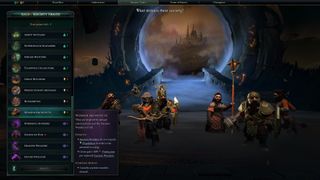
My empire was a devouring swarm of cannibal rats who liked to munch on corpses to heal themselves in battle. They were ruled over by an evil, froggy wizard king with a tall hat and a penchant for frying enemies with lightning. Driven by their ruler's thirst for knowledge, one of the themes I went with was dark magic, selecting the Dark tome for my first book of magic. That allowed me to curse my foes, while augmenting my own warriors with the ability to do more damage to enemies with negative status effects.
AoW4's spells are wide-ranging things, capable of not just turning the tide of the turn-based battles, but also improving cities and provinces, as well as enchanting units. Enchantments are AoW4's take on upgrades, giving your armies permanent bonuses and often changing their appearance. So your armies might eventually charge into battle with giant frost spikes sticking out of their backs, or maybe you'll turn your whole empire into a bunch of undead monstrosities.
The biggest gaming news, reviews and hardware deals
Keep up to date with the most important stories and the best deals, as picked by the PC Gamer team.
Pretty quickly I found myself in possession of a second tome, diversifying the trio of spell options I could pick from on the magic research screen. There are obvious synergies, and tomes that will feel more thematically appropriate for your empire—but I always follow the rule of cool. I wanted my magic to be badass. Fertility rituals were out, capturing the souls of my enemies was in.
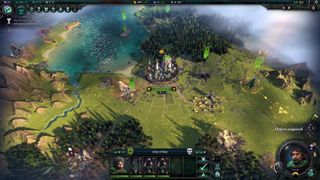
The choices you make are constantly being reinforced visually and mechanically, whether it's the ability to travel across the ocean or the appearance of your cities. Even when they're seemingly minor, they represent explicit decisions—nothing happens by accident. There's a wealth of feedback, most of it considerably more interesting than just seeing numbers going up.
The choices you make are constantly being reinforced visually and mechanically.
While other empires are trying to conquer the world or becoming masters of magic alongside you, they are only one small part of the lively maps you'll explore. Punctuating these kaleidoscopic lands are resource nodes that can be exploited by your settlements—often representing a tricky choice as you annex a new province and decide what resource you want to take advantage of—and hostile, unaffiliated armies.
These armies are usually occupying a node, so you'll want to wipe them out to take full advantage of it—but these encounters don't always end in combat. Instead, you'll sometimes find yourself dealing with an event with a variety of outcomes, some of them ending in battle anyway, while others might end with you actually recruiting your former foes. When a band of frost giants realised that my beefy, high-tier army was bound to crush them, they pleaded for their lives, and instead I gave them a job in my capital city, where they gave me a bonus to production at the cost of stability—tiny ratfolk do not, it turns out, want to live next door to massive monsters. They might also join your army, giving you access to units you otherwise wouldn't be able to field.
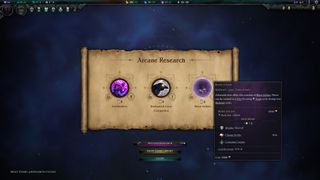
AoW4 is always spitting out events, but it happens even more frequently once you start encountering free cities. These are independent settlements which aren't playing to win, but are otherwise created from the same ingredient list that you and your opponents are formed from. And they're a chatty bunch. In one instance, I was invited to participate in a grand hunt, where I had to track down some wild hogs and butcher them, netting me a choice of several rewards, including the head of a piglet which I could display to show off my empire's supremacy. That was tempting, but instead I asked for one of the free city's elite units to bolster my army.
When you bump into a free city that isn't hostile, you can gift them with a Whispering Stone. From there, you can start seducing it into your empire, but the Whispering Stone can also serve as a spy or even syphon off tribute from another empire's vassal—as long as you've unlocked the prerequisite skill. As long as negative modifiers aren't dragging your relationship down, you'll befriend them over time. When I started befriending some death-obsessed tigrans, I was initially content to let our relationship develop naturally, but then another empire, a bunch of grim orcs who had been enthralled by a human enchantress, started muscling in. The race for the tigrans' allegiance was on.
Luckily, said enchantress, Karissa the Red, was a little preoccupied. She was at war with another empire, and I'd saved up a lot of Imperium, which can be spent on several things including encouraging a free city's allegiance. Before long our relationship had risen through the ranks, turning them into my first vassal, for which I received a nice chunk of income and access to the city's troops.
Fighting fantasy
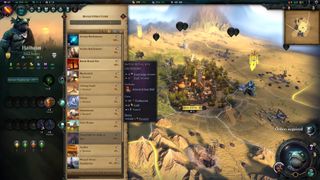
Making friends is nice and all, but what I really wanted to do was become powerful enough to tackle an Ancient Wonder. These points of interest are occupied by extremely tough armies, and even though—if you've fulfilled the prerequisites—the challenge can be lessened somewhat, they still represent some of the game's trickiest battles. While I was sailing through most of the turn-based brawls, these ones reliably kicked the shit out of me. The attempt is always worth it, though, because of the gold and magical artefacts you'll net from victory, and they can also be annexed for some beefy bonuses.
Ancient Wonders only let you select one army to fight with, but regular fights let you bring in multiple forces, making the scraps potentially huge, bloody affairs. The battle maps themselves range wildly, from big open fields to elaborate, menacing ruins. You'll need to take into account choke points, cover and environmental hazards, as well as the many abilities of your opponents. In low tier fights there's still plenty to consider, but things really start picking up once you start fielding troops with more unusual abilities, like massive bone golems who deposit skeleton warriors upon death. Your ruler and hero units are, obviously, the MVPs, since you can select new abilities for them every time they level up, on top of the equipment you can deck them out with.
The Cryptblade proved to be one of my favourite weapons. While I usually kept my froggy wizard away from the throng of bodies so he could spit out ranged spells, whenever I spotted a foe close to death I'd make a beeline for them, stab them with the dagger, and clap with glee as I watched them rise up again as a zombie under my thrall.

Sieges are a more involved type of scuffle, and my first one came about thanks to my tigran vassal. The tigran leader had a pair of daughters—one he was proud of, and another he was just weirded out by. I decided to help my buddy out and take the weirdo off his hands, making her a hero in my army. She proved to be an excellent addition, and after many turns of murdering monsters in my name, she came to me with a proposition: to help her hunt down a weapon known as Excessive Force. It was the main reason she had dreamed of a life of adventure, and she'd finally discovered its current location. Unfortunately it was locked up in the vault in a free city. This free city was a rat-infested place, but these rats were not, sadly, my pals. War it was, then.
We crushed them, naturally, and then threw their dead leader into the crypts before raising him as an undead minion to serve me for all time.
I descended upon the city with my three strongest armies, after sailing across the ocean. You can't just walk into a city and start a fight, though, so first I had to spend several turns chipping away at its fortifications. During this time you can also commission a siege project, if you've unlocked the ability, to undermine the enemy and make the upcoming battle a bit easier. I opted to mess up their defensive towers so they couldn't use them in the turn-based scrap. And after four turns of waiting, we got into some rat-on-rat action beneath the city's imposing walls. We crushed them, naturally, and then threw their dead leader into the crypts before raising him as an undead minion to serve me for all time.
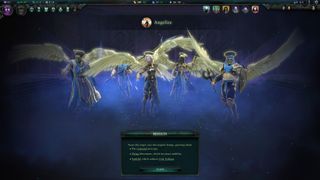
Victories like that feel even more meaningful than the climactic ones, where you win the game either through conquest, magic, expansion or points. Every time I saw my hero crushing a monster with Excessive Force, I was reminded of that great battle against the rats, our long journey across the ocean, and how it all began because she had a kinda shitty dad.
Ultimately, though, every victory is just a small part of a tapestry that records all of your deeds, and then rewards you for them. This is represented by the Pantheon system, where points earned in your campaigns can be spent on new gear, cosmetics and whole new realms. It serves to give you a little nudge and ask "Wouldn't you like to conquer the world one more time?"
Yes, I think I might.

Fraser is the UK online editor and has actually met The Internet in person. With over a decade of experience, he's been around the block a few times, serving as a freelancer, news editor and prolific reviewer. Strategy games have been a 30-year-long obsession, from tiny RTSs to sprawling political sims, and he never turns down the chance to rave about Total War or Crusader Kings. He's also been known to set up shop in the latest MMO and likes to wind down with an endlessly deep, systemic RPG. These days, when he's not editing, he can usually be found writing features that are 1,000 words too long or talking about his dog.

If you love big trucks, establishing trade routes, and the phrase 'post-apocalyptic survival business simulator' then I've got just the strategy RPG for you

Blizzard veteran David Kim's strategy comeback with Battle Aces is 'very personal:' 'I just can't accept... the end-all peak of RTS is StarCraft 2 and nothing can ever be better'
Most Popular


